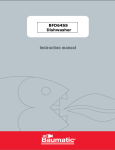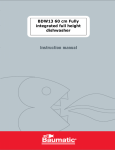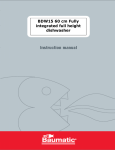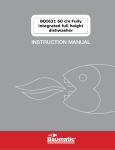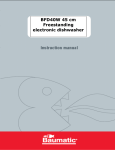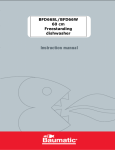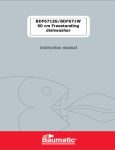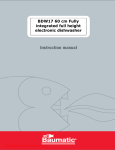Download Baumatic BFD64SS User manual
Transcript
BFD64SS 60 cm electronic dishwasher Downloaded from DishWasher-Manual.com Manuals USER MANUAL FOR YOUR BAUMATIC BFD64SS 60 cm electronic dishwasher. NOTE: This User Instruction Manual contains important information, including safety & installation points, which will enable you to get the most out of your appliance. Please keep it in a safe place so that it is easily available for future reference; for you or any person not familiar with the operation of the appliance. DD 31/10/07 2 Downloaded from DishWasher-Manual.com Manuals Contents Environmental note 4 Important safety information 5–7 Specifications Product dimensions Product specifications Energy efficiency details Electrical details 8 8 8 9 9 Description of the appliance Control panel Display window 9 10 10 Using your dishwasher Before first use Filling with dishwasher salt Setting the water softener level Filling with rinse aid Setting the rinse aid level Filling with dishwasher detergent 3 in 1 tablets before first use Loading the upper basket Adjusting the upper basket Loading the lower basket The cutlery basket Loading dishes and cutlery 11 11 11 12 13 13 14 14 15 16 17 17 18 Program table Setting a wash program Changing a wash program At the end of a wash program The 3 in 1 wash program Setting a delay start Setting a half load 20 20 – 21 21 21 22 23 23 – 24 Cleaning and maintenance The filter system Cleaning the filters Cleaning the spray arms Cleaning the control panel Cleaning the door 24 24 – 25 25 26 26 26 Error code failure system General troubleshooting 27 – 28 29 – 30 Installation Positioning and levelling the appliance Connecting to the mains water supply Water outlet Power supply 31 31 – 32 32 33 33 – 34 Contact details 35 – 12 – 14 – 15 – 18 – 19 3 Downloaded from DishWasher-Manual.com Manuals ENVIRONMENTAL NOTE Note: Before discarding an old appliance, switch off and disconnect it from the power supply. Cut off and render any plug useless. Cut the cable off directly behind the appliance to prevent misuse. This should be undertaken by a competent person. Disable the door lock to make sure that children cannot get stuck inside the appliance. o The packaging materials that Baumatic uses are environmentally friendly and can be recycled. o Please discard all packaging material with due regard for the environment. 4 Downloaded from DishWasher-Manual.com Manuals IMPORTANT SAFETY INFORMATION Your safety is of the utmost importance to Baumatic. Please make sure that you read this instruction booklet before attempting to install or use the appliance. If you are unsure of any of the information contained in this booklet, please contact the Baumatic Technical Department. General Safety o Repairs to your appliance must only be carried out by a Baumatic engineer or one of its authorized service agents. Any attempt by an inexperienced person to repair the appliance, could result in injury or damage to your dishwasher. o If you notice that the mains cable is damaged. The appliance must not be used. The same applies if you notice that the worktop, control panel or base area is damaged. As this could allow access to the internal components of the machine. o The appliance should be turned off and isolated from the mains supply, before either cleaning or maintenance work is attempted. o The mains cable must not be used to pull the plug out of the electrical socket. o The machine should not be sprayed with water. o The external surface of the appliance may become hot whilst your dishwasher is in use. o It is possible for small animals to chew either mains cables or water hoses, which could cause an electric shock hazard. Installation o The installation instructions contained within this user manual should be followed. o It is obligatory for the completed installation to comply with all relevant building regulations and local water authority requirements. o Before the first use of the appliance, you should follow the steps listed in the “Before first use” section of this manual. 5 Downloaded from DishWasher-Manual.com Manuals o Care should be taken not to trap the power supply cable underneath the appliance whilst installing it. o No attempt should be made to alter or modify the specifications of this appliance. In daily use o This appliance is only designed to wash normal domestic washloads. If you use your dishwasher in any other way or it is incorrectly used, then Baumatic accepts no liability for any damage that might be caused and any guarantee will be void. o It is recommended that the appliance is unplugged and the water supply is turned off after the machine is used. o The detergents, rinse aid and salt that you place in this appliance should be suitable for automatic dishwashers. With regards to dosage levels, the detergent manufacturer’s recommendations should be followed. o Sharp or knifes with long blades are a potential safety hazard when placed in an upright position in the cutlery basket. We would recommend that these items are placed horizontally in the upper basket. o You should not wash any items that have come into contact with corrosive, acidic or alkaline chemicals, paint, petrol, iron or steel debris. o You should not open the door whilst the appliance is set on a wash program. Depending on which stage that the wash program is at, hot water could escape the machine. o You should not leave the door of the appliance open, unless you are loading or unloading the dishwasher. o You should not stand or sit on the door when it is open. 6 Downloaded from DishWasher-Manual.com Manuals Child Safety o Your dishwasher should only be used by adults. You should not allow children in the area of the machine unsupervised. You should not let them touch the controls or play with the appliance. o It could be possible for a child or pet to gain access to the dishwasher if the door is left open. Therefore please check the inside of the appliance before setting it on a wash cycle. o Any packaging that is removed from the machine should be kept away from children. o All detergents should be kept out of children’s reach in a safe place. o Some water will remain inside the dishwasher when it has completed a wash cycle. This water is not suitable for drinking and may contain residues from the detergents that are used in the appliance. Declaration of conformity This appliance complies with the following European Directives: -73/23 dated 19/02/1973 Low Voltage Directive and subsequent modifications. -89/336 dated 03/05/1989 Electromagnetic Compatibility Directive and subsequent modifications. For future reference please record the following information which can be found on the rating plate and the date of purchase which can be found on your sales invoice. The rating plate of your dishwasher is located on the right hand side of the drop down door. Model Number ………………………………. Serial Number ………………………………. Date of Purchase ………………………………. 7 Downloaded from DishWasher-Manual.com Manuals Specifications Product dimensions: Height: Width: Depth: 850 mm 600 mm 600 mm Product specifications o 14 Place settings o 7 functions: o o o o o o o o o o o o o o o o Normal Intensive Economy Rinse Glass 3 in 1 Soak 4 Wash temperatures: 40°C, 45°C, 50°C, 60°C Electronic aqua stop Turbo drying LED display Delay timer Indicator of salt and rinse aid Half load function Concealed heating element Self cleaning stainless steel microfilter Anti leak device Anti flood device Quiet operation (49 dB) Top spray Height adjustable basket Collapsable plate racks Adjustable feet 8 Downloaded from DishWasher-Manual.com Manuals Energy efficiency details Energy efficiency class: A Washing performance class: A Drying performance class: A Electrical details Rated voltage: 230 Vac 50 Hz Supply connection: 13 A (double pole switched fused outlet with 3 mm contact gap) Description of the appliance 1) 2) 3) 4) 5) 6) 7) 8) 9) 10) 11) 12) Upper basket Spray arms Lower basket Water softener Main filter Detergent dispenser Cup shelf Cutlery basket Coarse filter Rinse aid dispenser Drain pipe connector Inlet pipe connector 9 Downloaded from DishWasher-Manual.com Manuals Control panel Display window The display window can show the following information:o o o o o o o o o o o o o Salt required 3 in 1 wash program selected Rinse aid required 1/2 load wash program selected Wash program time remaining Delay start time set Intensive wash program selected Normal wash program selected Economy wash program selected Rinse wash program selected Glass wash program selected Soak wash program selected Fault codes 10 Downloaded from DishWasher-Manual.com Manuals Using your dishwasher Before first use o Install the appliance as per the installation instructions contained within this booklet. o Fill the water softener with 1 litre of tap water and then fill with specialist dishwasher salt. After this you should set the water softener level. o Fill the rinse aid dispenser and then set the rinse aid doseage. Filling with dishwasher salt IMPORTANT: You should only use salt that is specially designed for use in a dishwasher. If any other type of salt is used in the appliance (in particular table salt), it will damage the water softener. o Ideally you should fill the water softener with salt, just before you are about to run a wash program. This will help to clear any salt that may have overflowed from the water softener during the salt filling process. o Open the door of the dishwasher and then remove the lower basket. The basket should be empty when you remove it. o Turn the salt container cap anticlockwise and remove it. o Pour 1 litre of water into the water softener container. IMPORTANT: It is only necessary to do this when you fill the container with salt for the first time. o Pour salt into the salt container, using the funnel that is supplied with the appliance. You should add approximately 1.2 kg of salt into the container. o It is perfectly normal for a small amount of water to come out of the salt container, whilst you are filling it with salt. This does not mean that the container is filled with the necessary level of salt. o Refit and fully tighten the salt container cap. 11 Downloaded from DishWasher-Manual.com Manuals o The salt required warning light will go out approximately 2-6 hours after you have filled the salt container with salt. When the salt required warning light comes on again, then you should follow the filling with dishwasher salt procedure again. IMPORTANT: you do not need to pour 1 litre of water into the container when you subsequently fill the water softener with salt. Setting the water softener level It is possible to regulate the amount of salt that the water softener will release during a wash cycle. The water softener should be set to a level that is appropriate for the hardness of your water (please refer to the table below). To alter the amount of salt that is released by the water softener, you should:o Remove the lower basket and unscrew the cap from the salt container. o Locate the ring with an arrow on it that is located on the salt container. (See figure opposite). o When you first receive your appliance, the arrow will be pointing to the minus symbol. Using the water hardness chart, you should turn the ring anti-clockwise to the setting that is appropriate for your water hardness. o The “middle” selector position is halfway between the minus and plus symbols. o If your water is already sufficiently soft or you are going to exclusively use the 3 in 1 wash program in conjunction with 3 in 1 dishwasher tablets, then the ring can be turned to any position. However the salt container should not be filled with salt. 12 Downloaded from DishWasher-Manual.com Manuals Filling with rinse aid The rinse aid is released during the final rinse and it helps to prevent water from forming droplets on your dishes. These droplets will lead to spots and streaks being left on items after the wash program has completed. o Your dishwasher is designed to utilise liquid rinse aids. o The rinse aid dispenser is located inside the drop down door, next to the detergent dispenser. o To access the rinse aid dispenser, you should turn the cap anticlockwise and it will pop out of the hole. Then slowly pour in liquid rinse aid, the rinse aid dispenser will hold approximately 140 ml of rinse aid. o You should continue to fill with rinse aid, until the level indicator turns completely black. o Be careful not to overfill the dispenser, as this could cause oversudsing when a wash program is selected. Wipe away any rinse aid excess or spillages with a damp cloth. o Replace the cap and turn it clockwise until it locks into position. o You should refill the rinse aid dispenser when the snowflake symbol appears in the display window. Setting the rinse aid level The amount of rinse aid that the dishwasher requires also depends on the hardness of your water. You should experiment with the rinse aid setting, until you find a level that gives the best results. o On the first wash cycle, we would recommend that the rinse aid level is set to number 2. o If you get water spots and poor drying performance, then you should turn the arrow anticlockwise and increase the setting to the next number. 13 Downloaded from DishWasher-Manual.com Manuals o You should continue to adjust the rinse aid level upwards until you get no water spots. o If you get cloudiness or streaking on your dishes, the rinse aid level is set too high and it is causing foaming during the wash cycle. Turn the arrow clockwise and lower the setting to the next number. Filling with dishwasher detergent The detergent dispenser must be refilled at the start of each wash cycle (apart from the Soak and Rinse wash programs). o Open the lid that closes over the detergent dispenser and place the detergent inside of the dispenser. o Only one detergent tablet should be placed in the dispenser at any one time. If you are using detergent powder or liquid, you should follow the detergent manufacturer’s recommendations. o Shut the detergent dispenser lid and position the clip on the outer edge, so that it holds the lid shut. o At the beginning of a wash cycle the clip will open and the tablet/powder/liquid will enter the dishwasher. 3 in 1 tablets before first use IMPORTANT: If you are using 3 in 1 dishwasher tablets, then you MUST follow this set up process before using the appliance. o Open the door of the dishwasher and then remove the lower basket. The basket should be empty when you remove it. o Turn the salt container cap anticlockwise and remove it. o Pour 1 litre of water into the water softener container. o Refit and fully tighten the salt container cap. 14 Downloaded from DishWasher-Manual.com Manuals o To access the rinse aid dispenser, you should turn the cap anticlockwise and it will pop out of the hole. o Turn the arrow clockwise until it moves past the number 1, this deactivates the rinse aid dispenser. o IMPORTANT: There is no need to put rinse aid or dishwasher salt in the appliance if you are using 3 in 1 detergent tablets. You must ONLY use the 3 in 1 wash program when using 3 in 1 tablets. If you wish to switch from 3 in 1 tablets to a detergent that doesn’t include rinse aid and salt, you must fill your dishwasher with salt and rinse aid. Please follow the relevant sections in the instruction booklet. You do not need to pour 1 litre of water into the salt container, as you will have already done this previously. Loading the upper basket The upper basket is most suited to washing delicate and light dishware, such as glasses, coffee & tea cups, saucers, plates, bowls and shallow pans (that are not heavily soiled). 1. 2. 3. 4. 5. 6. 7. Cups Small serving bowl Large serving bowl Glasses Saucers Dish Dessert dishes o You should position the dishes and cookware in such a way that they are not moved by the spray of water during the wash cycle. o Use the diagram above as a guide on the most appropriate way to load the upper basket. 15 Downloaded from DishWasher-Manual.com Manuals Adjusting the upper basket Your dishwasher has an adjustable upper basket which you can alter to the most suitable position for the items you are going to wash in the upper basket. The height of the upper basket can be adjusted by pulling the handle on either side of the basket upwards until it clips into place. Position 1 (upper position) o For accommodating items such as glass tumblers and wine glasses. Wine glasses should be placed upside down, so that the stem of the glass rests in one of the grooves on the side flap. Position 2 (lower position) o For accommodating additional tumblers, cups and mugs. You can also place small, expresso sized cups on top of the side racks. Care should be taken to make sure that there is enough clearance between the top of the cups placed on top of the side racks and the underneath of the dishwasher interior. o Please note that when the basket is in the upper position, you cannot have the side flaps in a raised position. Otherwise the basket will not slide back into the interior of the dishwasher. With upper basket raised With upper basket lowered Maximum height of dishes (upper basket) 19 cm 24 cm Maximum height of dishes (lower basket) 30 cm 25 cm 16 Downloaded from DishWasher-Manual.com Manuals IMPORTANT: Care should be taken to make sure that the spray arms can move freely when items have been loaded into the baskets. IMPORTANT: Care should be taken when placing long stemmed glassware, such as champagne glasses in the upper basket. If they are not positioned correctly, then there is a risk that they may topple over when the upper basket is pushed in our pulled out. Loading the lower basket The lower basket is most suited to washing larger and more heavily soiled items, such as saucepans, saucepan lids and serving dishes. You can also load bowls and a variety of plates into the lower basket. 7. 8. 9. 10. 11. Dessert dishes Serving plate Side plates Dinner plates Cutlery basket o Saucepans and serving bowls must always be placed with their bases upwards. o Deep saucepans should be slanted, to allow water to run off. o The bottom rack has prongs at the rear of the basket that can be folded downwards, to allow for easier loading of larger saucepans and serving bowls. The cutlery basket Cutlery should be placed inside of the cutlery basket. The cutlery basket should then be placed in the appropriate position in the lower basket. o For the best washing performance, cutlery should be placed through the slots in the top of the cutlery basket. 17 Downloaded from DishWasher-Manual.com Manuals o For ease of loading, it is possible to split apart the outer section of the cutlery basket. However this outer section should not be placed individually into the cutlery basket, it should always be attached to the main basket. IMPORTANT: Do not allow items of cutlery to fall through the bottom of the cutlery basket, as this may cause damage to the spray arm and/or the cutlery. If the bottom of the basket begins to deteriorate and allows items to fall through, you should replace the cutlery basket. Loading dishes and cutlery Household cloths, sponges or any other object that may absorb water SHOULD NOT be washed in a dishwasher. o Remove leftovers and soften the remnants of burnt food in pans, prior to loading dishes in the appliance. o Once the dishwasher has been loaded, check that the spray arms can move freely. If the spray arm comes into contact with any item, then you should rearrange the wash load. o Cups, glasses, pans etc should all be loaded with their bases upwards, so that water does not collect inside of them. o Cutlery and dishes should not cover each other, otherwise you may get poor wash results. o Do not allow glasses to touch inside the dishwasher, otherwise damage may occur. o Small objects can be placed inside of the cutlery basket. 18 Downloaded from DishWasher-Manual.com Manuals The following items are NOT suitable for washing inside a dishwasher:o Cutlery with a handle of mother-of-pearl, wood, horn or china. o Plastic items that are not resistant to heat. o Cutlery that consists of glued parts that are not resistant to heat. o Cutlery items or crockery that are bonded. o Copper or pewter items. o Lead crystal glass. o Wooden platters o Synthetic fibre items. The following items are not always suitable for washing inside a dishwasher:o Stoneware should only be washed if the manufacturer of the item has marked it as dishwasher safe. o Plastic items (such as lunchboxes) should only be washed if the manufacturer has marked it as dishwasher safe. o Glazed crockery may fade with repeated washing inside of a dishwasher. o Items made of silverware or aluminium can discolour when washed inside a dishwasher. o Any food residue should be removed from silver items immediately, as this can also result in discolouration. o Certain types of glass may become dull or cloudy after a large number of washes. 19 Downloaded from DishWasher-Manual.com Manuals Program table * P3 Normal is the testing program for EN 50242. Setting a wash program Make sure that the before first use section has been followed. o Check whether the appliance needs rinse aid or salt adding to it. o Pull out the top and bottom baskets, then load them in accordance with the loading instructions. o Push the top and bottom baskets fully back into position. o Add detergent 20 Downloaded from DishWasher-Manual.com Manuals o Turn the appliance on by using the ON/OFF button. o Press the program selection button to choose an appropriate wash program for the load that you are washing. The number of the wash program that you have selected will appear in the program indicator. o Select any program options that you want to use (e.g. delay start or half load). o Close the door firmly, so that you hear the door lock click shut. o After a few seconds, you will hear the appliance begin to fill with water and the wash program will have started. o The display window will show the wash program that you have selected and the time remaining to the end of the wash program. Changing the wash program o Turn off the power using the ON/OFF button. o Wait for a minute and then open the door of the appliance. o Turn the appliance on by using the ON/OFF button o Use the program selection button to choose the correct wash program. o Select any program options that you want to use (e.g. delay start or half load). o Close the door firmly, so that you hear the door lock click shut. o After a few seconds, you will hear the appliance begin to fill with water and the wash program will have started. At the end of a wash program o The time display will flash for 8 seconds and a buzzer will sound. o If you have used the delay start mode, the time display will flash for 8 seconds but the buzzer will not sound. o Open the door of the appliance. o Use the ON/OFF button to switch the dishwasher off and unload the dishwasher. 21 Downloaded from DishWasher-Manual.com Manuals The 3 in 1 wash program IMPORTANT: Before using the 3 in 1 wash program, make sure that you have followed the “3 in 1 tablets before first use” section. Make sure that the water softener has not got any salt in it. If there is still salt in it, then turn the water softener to its lowest setting. Make sure that the rinse aid dispenser has been set so it does not dispense rinse aid. THIS WASH PROGRAM MUST BE SELECTED IF YOU ARE USING 3 IN 1 DETERGENT. IF YOU USE ANY OTHER WASH PROGRAM WITH 3 IN 1 TABLETS, THEN YOU MAY GET POOR WASH RESULTS. o Hang the 3 in 1 tablet container on the underneath of the upper basket, in the position shown on the diagram. o Check that the 3 in 1 tablet container is not going to foul the upper spray arm, by rotating the spray arm around slowly. If it does hit the 3 in 1 tablet container, you should move the container. o Put a 3 in 1 tablet inside the 3 in 1 tablet container. Load the appliance as normal and select the 3 in 1 wash program. If your wash results are poor, then we would recommend that you use a dishwasher detergent that doesn’t have rinse aid and salt included in the tablet. Fill the appliance with rinse aid and dishwasher salt, then set them so they dispense the appropriate amount for your water hardness. 22 Downloaded from DishWasher-Manual.com Manuals Setting a delay start It is possible to delay the start of the wash program for up to a maximum of 24 hours. o Check whether the appliance needs rinse aid or salt adding to it. o Pull out the top and bottom baskets, then load them in accordance with the loading instructions. o Push the top and bottom baskets fully back into position. o Add detergent o Turn the appliance on by using the ON/OFF button. o Press the program selection button to choose an appropriate wash program for the load that you are washing. The number of the wash program that you have selected will appear in the program indicator. o Press the delay start button and you will see the amount of time that you are delaying the wash program by, appear in the program indicator. o Close the door firmly, so that you hear the door lock click shut. o The display window will show the time delay that you have set. o Once the period of time has passed, the dishwasher will start the wash program that you selected. Setting a half load The half load option means that the lower spray arm does not run. IMPORTANT: You should only load items in the upper basket when using the half load option. o Check whether the appliance needs rinse aid or salt adding to it. o Pull out the top baskets, and then load it in accordance with the loading instructions. o Push the top and bottom baskets fully back into position. 23 Downloaded from DishWasher-Manual.com Manuals o Add detergent o Turn the appliance on by using the ON/OFF button. o Press the program selection button to choose an appropriate wash program for the load that you are washing. The number of the wash program that you have selected will appear in the program indicator. o Press the half load button, the half load light will come on. o Close the door firmly, so that you hear the door lock click shut. o After a few seconds, you will hear the appliance begin to fill with water and the wash program will have started. o The display window will show the wash program that you have selected, the time remaining to the end of the wash program and that you have chosen the half load option. Cleaning and maintenance IMPORTANT: The appliance should be disconnected from your mains supply before commencing any cleaning process. The filter system Your appliance is fitted with three levels of filtering; these are located in the base of the dishwasher for ease of access. Main filter- 1) Main filter 2) Coarse filter 3) Fine filter Food and soil particles are trapped by this filter and pulverised by a special jet on the lower spray arm. This debris is then washed down the drain. 24 Downloaded from DishWasher-Manual.com Manuals Coarse filter- Larger items such as pieces of bone or glass, which could clog the drain are trapped in this filter. Fine filter- This filter holds soil and food residue in the sump area and prevents it from being redeposited on the dishes during a wash cycle. IMPORTANT: Whilst the filtering system is efficient, your dishwasher is not a waste disposal unit. All items being washed inside of the dishwasher, should have food scraps removed from them before being loaded into the appliance. Cleaning the filters For best performance and results, the entire filter assembly should be thoroughly cleaned regularly (ideally after each wash cycle). o Lift the handle of the filter and gently lift out the main and coarse filter, then rinse out these sections under a tap to remove any food debris that remains in them. o Pull out the fine filter and also rinse this under the tap to remove any food debris that is trapped in it. o Place the fine filter back in its original position. o Place the main and coarse filter back into their original positions in the base of the dishwasher. IMPORTANT: THE DISHWASHER SHOULD NEVER BE SET ON A WASH CYCLE WITHOUT THE FILTERS BEING INSIDE OF THE APPLIANCE. 25 Downloaded from DishWasher-Manual.com Manuals Cleaning the spray arms The spray arms should be cleaned regularly, to prevent hard water deposits from clogging the spray arm jets and bearings. o To remove the spray arm, unscrew the nut and take out the washer that sits on top of the spray arm. o Gently pull upwards to remove the spray arm. o Wash the spray arm in warm, soapy water and use a soft brush to clean the jets. o Rinse the spray arm thoroughly and then reassemble the spray arm back in its original position. Cleaning the control panel IMPORTANT: Do not use any abrasive cleaner or household polish on either the control panel or operating parts. 9 Wipe over the control panel using a brand new damp cloth with warm water. Cleaning the door o To clean the edge around the outside of the door, you should use a soft, damp cloth only. o To prevent water from penetrating the door lock or electrical components, DO NOT use a spray cleaner of any kind. o DO NOT use any abrasive cleaner or scouring pads on the inner or outer surfaces, as they may cause damage to the surfaces. 26 Downloaded from DishWasher-Manual.com Manuals Error code failure system If your appliance senses that it is not operating correctly, then an error code may appear in the display window. The following error codes can possibly be remedied by the customer and the steps outlined below should be followed. BEFORE COMPLETING ANY MAINTAINEANCE ON THE APPLIANCE, IT SHOULD BE DISCONNECTED FROM YOUR MAINS POWER SUPPLY. E1 o 9 9 9 9 Longer than expected fill time. Check the water pressure of your mains water supply. Clean the mesh filter that sits in the inlet hose. Ensure that the inlet hose is not kinked or crushed. Make sure the water tap that the machine is connected to is turned on fully. E2 o Longer or extended drain time. 9 The drain pipe may be placed in too high a position or incorrectly. Check the installation instructions and ensure that the installation is correct. 9 Check that the outlet hose is not kinked or crushed. 9 Make sure that the drain hose has not extended beyond its original length. E3 o Longer heating time- not reaching the required temperature. 9 Malfunction of the temperature sensor or heating element. 9 Call Baumatic Service Department. E4 o The machine has sensed water in the base. 9 Check that the outlet hose is not kinked or crushed. 9 Check that there are no blockages in the drain hose or the drainage system that the appliance is connected to. 9 The drain pipe may be placed in too high a position or incorrectly. Check the installation instructions and ensure that the installation is correct. 9 Oversudsing being caused by a 3 in 1 detergent tablet being used with separate salt and/or rinse aid. 27 Downloaded from DishWasher-Manual.com Manuals 9 LEAVE THE APPLIANCE SWITCHED OFF FOR 24 HOURS AND THEN SWITCH IT BACK ON, IF E4 REAPPEARS THEN CONTACT THE BAUMATIC SERVICE DEPARTMENT. E5 o Switch cannot shut off automatically- program not finishing its cycle. 9 Low voltage or power switch failure. 9 Call Baumatic Service Department. E6 o Open circuit 9 Thermistor 9 Call Baumatic Service Department. E7 o Short circuit 9 Thermistor 9 Call Baumatic Service Department. Once you have taken action to rectify the problem that has caused the fault code to appear, plug the machine back into your mains power supply. Turn the machine on using the ON/OFF button. IMPORTANT: If any other fault code appears in the display window, you should not attempt to clear it yourself and contact the Baumatic Service Department. IF THE FAULT CODE REAPPEARS AFTER FOLLOWING THE ABOVE ADVICE AND CLEARING THE FAULT CODE. YOU SHOULD TURN OFF THE APPLIANCE; DISCONNECT THE APPLIANCE FROM YOUR MAINS SUPPLY. THEN ARRANGE FOR AN ENGINEER TO ATTEND THE APPLIANCE. YOU SHOULD CONTACT BAUMATIC SERVICE ON TELEPHONE NUMBER (0118) 933 6911. IF AN ENGINEER ATTENDS DURING THE GUARANTEE PERIOD AND FINDS THAT A FAULT HAS BEEN CAUSED BY AN ITEM ON THE ERROR CODE LIST, WHICH COULD HAVE BEEN CLEARED BY THE CUSTOMER. THEN YOU MAY BE LIABLE FOR THE COST OF THE SERVICE CALL. 28 Downloaded from DishWasher-Manual.com Manuals General troubleshooting PROBLEM Dishwasher doesn’t run POSSIBLE CAUSES Fuse blown or the circuit breaker has tripped Power supply is not switched on Water pressure is low Drain pump doesn’t stop Overflow Noise Some audible sounds are normal Suds in the tub Replace the fuse or reset the circuit breaker. Remove any other appliances that are sharing the same circuit with the dishwasher. Make sure that the dishwasher is turned on and that the door is closed securely. Make sure that the power cord is fully plugged into the wall socket. Check that the water supply is connected properly and that the water is turned on. The system is designed to detect an overflow. If it does, then it will run the drain pump continuously when there is power to the appliance. You will get a level of operating noise during a wash cycle, in particular when food is being removed from items and when the detergent dispenser places the tablet into the tub. Utensils are not secure in the baskets or something small has dropped into the basket Ensure that everything is loaded as per Baumatic’s loading instructions. Motor hums If the dishwasher is not going to be used for a period of time, then you should make sure that the appliance is set on a wash program once a week. Otherwise the seal around motor may dry out and cause noise. Improper detergent use Ensure that you are not using 3 in 1 detergent tablets, in conjunction with rinse aid and salt. Always wipe up any excess rinse aid or rinse aid spillages immediately. Spilled rinse aid Stained tub interior Dishes are not fully dried WHAT TO DO Detergent with colourant was used Rinse aid dispenser is empty Use a detergent without colourant. Make sure that the rinse aid dispenser is filled with rinse aid. 29 Downloaded from DishWasher-Manual.com Manuals Dishes and pans are not clean Improper program Spots and filming on glasses and pans Extremely hard water Low inlet temperature Improper loading Improper detergent Incorrect salt/rinse aid levels Steam A normal phenomenon You may get a small amount of steam coming through the vent by the door latch, during drying and water draining. Black or grey marks on dishes Aluminium utensils have rubbed against dishes Use a mild abrasive cleaner to eliminate the marks. Make sure that the appliance is loaded correctly in future. Water standing in the bottom of the tub This is normal A small amount of clean water in the base of the appliance is not something to be concerned about. Dishwasher leaks The rinse aid dispenser is overfilled or rinse aid has been spilt inside the appliance Take care not to overfill the rinse aid dispenser. Spilt rinse aid could cause oversudsing and lead to overflowing. Wipe away any spills immediately with a damp cloth. Improper loading Dishwasher isn’t level Select a more intense wash program. Make sure that the spray arms and the detergent dispenser are not being impeded by large dishes. Refer to the relevant sections of this booklet, to ensure that the detergent, salt and rinse aid levels are set correctly. Ensure that the appliance is loaded correctly. Make sure that the dishwasher is level. 30 Downloaded from DishWasher-Manual.com Manuals Installation IMPORTANT: THIS INSTALLATION MUST BE COMPLETED BY A SUITABLY QUALIFIED PERSON. BAUMATIC ONLY SANCTION THE INSTALLATION GIVEN IN THIS INSTRUCTION MANUAL. YOU SHOULD DISPOSE OF ALL PACKAGING IN AN ENVIRONMENTALLY FRIENDLY MANNER. Positioning and leveling the appliance 9 Remove all packaging from the outside and inside of the dishwasher. 9 Place the dishwasher on a solid and level floor surface. 9 DO NOT PLACE THE DISHWASHER ON A CARPET. 9 Loosen the adjustable feet that are positioned on the base of the appliance. 9 Adjust each of the four feet until the appliance is level. 31 Downloaded from DishWasher-Manual.com Manuals IMPORTANT: When the dishwasher is positioned in the location where it will be used. Make sure that all four feet are resting firmly on the floor, by pressing down on each corner and checking that the appliance stands still. Connecting to the mains water supply IMPORTANT: Do not connect the appliance to your mains water supply using an old or an existing water inlet hose. The inlet hose supplied with the dishwasher is the ONLY one that should be used. DO NOT CONNECT THE WATER INLET HOSE TO A HOT WATER TAP. o The inlet hose will be located inside the cabinet of the dishwasher. o Connect the water inlet hose to a threaded water tap that has a 3/4” thread. o Fully tighten the inlet hose to the water tap. IMPORTANT: The inlet hose is fitted with an aqua stop. This MUST be fitted in the upright position, as shown in the above diagram. 32 Downloaded from DishWasher-Manual.com Manuals Water outlet 9 Secure the drain hose, so that it cannot move whilst the dishwasher is in use. 9 Place the end of the drain hose on your drain pipe. Push it a short way down into your drain pipe. 9 IMPORTANT: Do not insert the drain hose too deeply into the water pipe, as this may cause siphoning. 9 NEVER EXTEND THE DRAINAGE HOSE FROM ITS ORIGINAL LENGTH. Power supply 9 IMPORTANT: The electrical socket must still be accessible once the appliance is installed. 33 Downloaded from DishWasher-Manual.com Manuals 9 Consult the rating plate, located on the right hand side of the drop down door BEFORE making the electrical connections. Ensure that the voltage reaching the plug is the same as that on the rating plate. 9 DO NOT REMOVE THE RATING PLATE AS THE INFORMATION ON IT IS IMPORTANT. 9 The moulded plug that is supplied with the appliance must be placed into an earthed and insulated socket. 9 Broken or damaged power leads must only be replaced by a suitably qualified person. A power lead of a similar type must be used in replacement. 9 Power lead type – H 0 V V – F 3G 1,5. 9 IMPORTANT: We do not recommend that this appliance is connected to an extension lead. 34 Downloaded from DishWasher-Manual.com Manuals United Kingdom Baumatic Ltd., Baumatic Buildings, 6 Bennet Road, Reading, Berkshire RG2 0QX United Kingdom Sales Telephone (0118) 933 6900 Sales Fax (0118) 931 0035 Service Telephone (0118) 933 6911 Service Fax (0118) 986 9124 Spares Telephone (01235) 437244 Technical Advice Telephone (0118) 933 6933 Czech Republic Baumatic CR spol s.r.o. Amperova 495 46215, Librec Czech Republic +420 800 185 263 www.baumatic.cz Slovak Republic Baumatic Slovakia, s.r.o. Skultetyho 1 831 04 Bratislava 3 Slovakia +421 255 640 618 Germany Baumatic Gmbh Janderstrasse 9 Mannheim, 68199 Germany E-mail: [email protected] [email protected] +4962 112 9190 Website: www.baumatic.co.uk Italy Baumatic Italia S.R.L. Via Caltana 129 Campodarsego (Padova), 35011 Italy Republic of Ireland 01- 6266 798 www.baumatic.de +3904 9920 2297 www.baumatic.it Holland Baumatic Benelux B.V. Grindzuigerstraat 22 1333 MS ALMERE The Netherlands +3136 549 1555 www.baumatic.nl 35 Downloaded from DishWasher-Manual.com Manuals 36 Downloaded from DishWasher-Manual.com Manuals




































